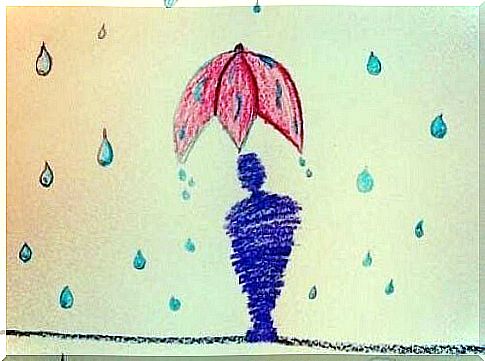Test Of The Person In The Rain

The rain person test is one of the best known projective tools along with the Rorschach test and the tree test. These are complementary techniques that are useful for gathering more information about the personality of patients or candidates in a recruitment process. However, it should be remembered that these are tools that are not exempt from criticism.
Projective tests fall within the framework of psychoanalytic theory, which is why they carry a rather controversial approach from a scientific point of view. Their interpretations, in fact, may seem somewhat subjective. However, it should not be forgotten that these tests have been used for decades and that their systematization has been refined.
The test of the person in the rain, for example, appeared in 1924. It was the psychologist HM Fay who designed a test called A lady walking in the rain to assess the psychological maturity of the children between 6 and 10 years old. Since then, the test has changed dramatically and is given to both adults and children.
Currently, this projective test is used in the field of personnel selection and in the field of child psychology to evaluate different aspects of the personality of the child or adolescent. However, it should be noted that these are neither standardized tests nor aimed at establishing specific diagnoses.

Test of the person in the rain: what information does it offer?
Administering the person test in the rain is pretty straightforward – just provide the patient with a sheet of paper and a pencil and ask them to draw a person in the rain. Beyond the artistic skills, there are several factors that this classic instrument tries to evaluate.
The test places the person under examination in a more or less moderate stress situation. A drawing has to be done within a certain time, which also requires a certain amount of inventiveness, skill and precision.
However, the quality of the design is the least important. If anything, the symbolic factor counts, the aspect that the professional will have to interpret.
The figure in a hostile environment
The task is to draw a figure in the rain, interpreting the rain or storm as a disturbing element. This forces the adult or child to put someone on paper facing a relatively unfavorable circumstance. But how does he deal with it?
- Let’s not forget that the test is called “person in the rain”. The first thing to do, therefore, is to choose the protagonist of the drawing : a man, a woman, but also an animal, a tree or a flower (the latter is a frequent subject among children).
- Next, we need to think about how to protect the figure from the rain : what resources does it have? Do you have an umbrella, a suitable garment? Is she protected by something or is she helpless in the middle of the weather?)
- Is the figure calm, happy, does it show courage or does it feel fear?
This set of elements evokes, in a certain sense, the imprint of the patient’s or candidate’s inner world in the selection process. It also outlines his mood and even his attitude towards difficulties.

How is the test administered?
As already pointed out, it is a rather easy projective tool to administer. In this sense, some specific steps must be followed:
- Before handing over the test sheet, the practitioner must converse with the child or adult to create an atmosphere of trust and relaxation. It is important to make the person feel at ease, so that through the drawing he evokes his inner world, his personality and his state of mind.
- Once a certain degree of confidence has been established, the professional hands over the blank sheet with the following instruction “draw a person in the rain”. Also, let the person know that the quality of the drawing is not evaluated, which is not an important aspect. There is no set time, but in general it is advisable not to exceed 15 minutes.
- Once the drawing is finished, you can ask the person to make another one with the same figure but this time without the rain. In this way, a comparison can be made.
Test evaluation of the person in the rain
It is common to think that projective tests have a subjective interpretation. However, these tools have been revised over the years and already have some specific parameters at the time of evaluation.
These include the fundamental aspect of the person’s behavior during the execution of the drawing (if he understands the instructions, has doubts, is nervous, makes corrections, asks for another sheet, etc.).
- Analyze the dimensions. There are those who draw tiny figures under a sky full of huge clouds. A detail that could highlight anxiety, shyness, insecurity.
- Lines cured, if there are many straight lines with a strong stroke (presence of anxiety). Or if there are many angles, spikes, etc., which can reveal some aggression.
- At the same time, the practitioner evaluates the sequence of execution of the drawing to see if there is some planning. Was the umbrella drawn before the rain? Or was the rain drawn before deciding how to protect the figure from the disturbing element?
- Analyze the movement of the figure and the emotional charge that the drawing releases. There are those who draw a little man in the corner of the page without means of protection and in the inclement rain and thunder.

To conclude
The test of the person in the rain can provide interesting information as long as it is administered together with other diagnostic tests that support the meaning of the hypothesized diagnosis, in addition to individual interviews.
In the case of child psychology, drawings are always a useful resource as well as a motivating factor that pushes the child to express himself.
Finally, this tool, like the Rorschach test, requires adequate training in order to obtain the maximum result. These are undoubtedly interesting resources and worth considering in certain cases.









